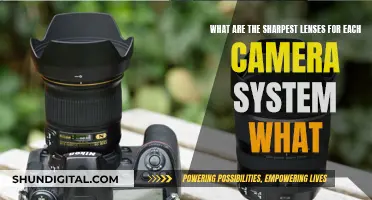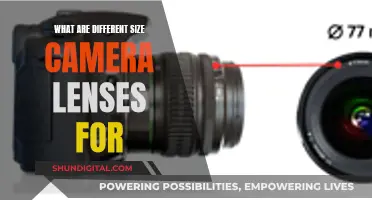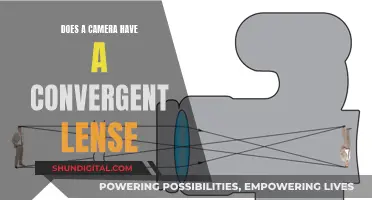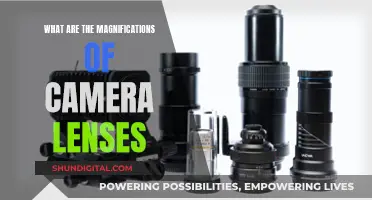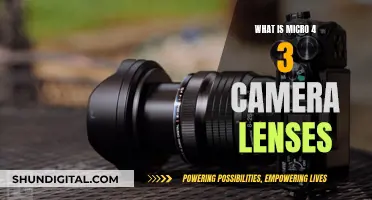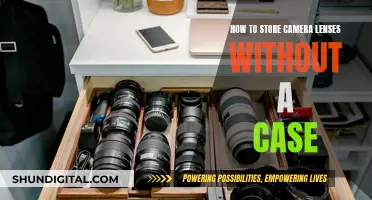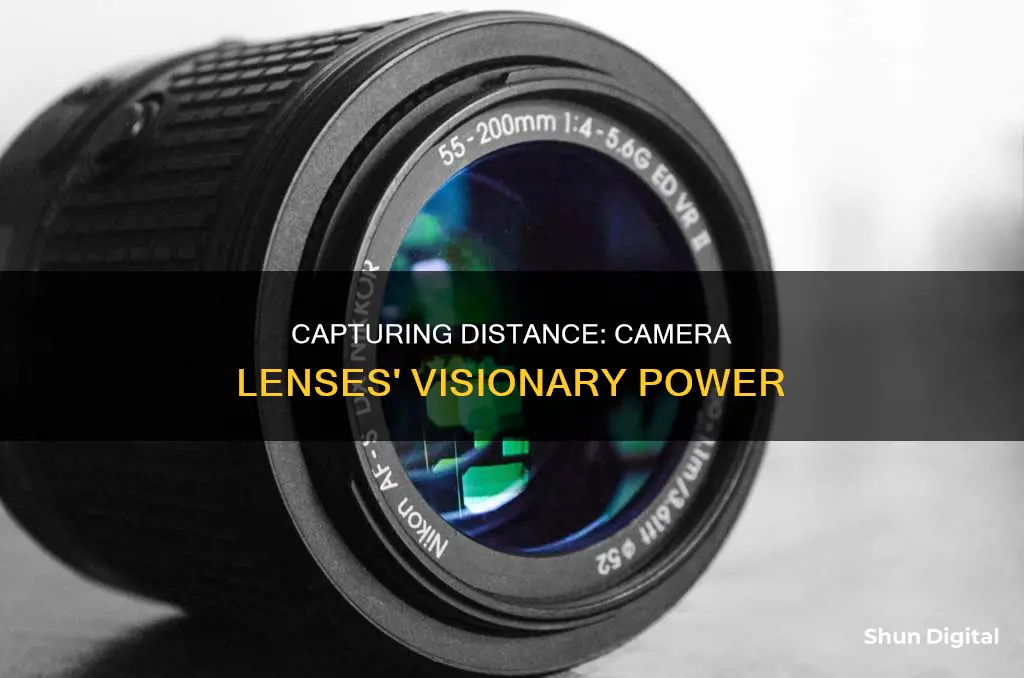
The range of a camera lens depends on several factors, including focal length, resolution, lighting conditions, and the size of the object in view. A camera lens with a smaller focal length will have a wider field of view but will capture less detail, while a larger focal length will result in a narrower field of view and more detailed images. The resolution of the camera also plays a crucial role in determining the range, as higher-resolution cameras can capture more detail at greater distances. Additionally, the size of the object being captured and the lighting conditions can impact the effective range of the camera lens.
| Characteristics | Values |
|---|---|
| Range | 0-70 feet for home security cameras, 0-700 feet for professional cameras |
| Focal Length | The smaller the focal length, the wider the field of view. The larger the focal length, the narrower the field of view. |
| Resolution | The higher the resolution, the clearer the image. |
| Placement | Obstructions such as concrete floors, large trees, walls, and bricks can weaken a wireless security camera's signal strength. |
| Camera Quality | Top security camera brands are far more reliable than unknown brands. |
What You'll Learn
- Focal length: Smaller focal length = wider field of view. Larger focal length = narrower field of view
- Resolution: Higher resolution = clearer image
- Camera placement: Obstructions can weaken signal strength
- Camera quality: Higher-quality cameras have better hardware and software
- Night vision: IR, lux rating and type of LEDs are important

Focal length: Smaller focal length = wider field of view. Larger focal length = narrower field of view
The focal length of a lens is a fundamental parameter that describes how strongly it focuses or diverges light. A lens with a smaller focal length will have a wider field of view and a lens with a larger focal length will have a narrower field of view.
The focal length of a lens is the distance between the plane of the sensor and the optical centre or nodal point of the lens. This determines the lens's angle of view. In a simple lens containing just one element, the focal length is the distance in millimetres between the focal plane and the centre of the element when the lens is focused at infinity.
A lens with a shorter focal length bends the rays more sharply, bringing them to a focus in a shorter distance or diverging them more quickly. Conversely, a lens with a longer focal length (lower optical power) leads to higher magnification and a narrower angle of view.
In photography, the longer the focal length, the narrower the area of the scene captured by the lens. This means that a lens with a short focal length captures a much broader view than a lens with a longer focal length. For example, a lens with a focal length of 24mm produces a wide angle of view, whereas a lens with a focal length of 1200mm produces a narrow angle of view.
The focal length of a lens also determines whether you capture a wide vista or a close-up of a distant subject. A shorter focal length is ideal for sweeping landscape shots or environmental portraits, whereas a longer focal length is ideal for photographing small and distant subjects.
Tomorrow's Eclipse: Camera Lenses at Risk?
You may want to see also

Resolution: Higher resolution = clearer image
The resolution of a camera is one of the factors that determine how far a security camera can see. The resolution of a camera is associated with a number of different factors, such as print size, cropping options, down-sampling, and display size.
The higher the resolution, the larger the potential print size. Printing from digital images is accomplished by squeezing a certain number of pixels per inch (PPI). A high-quality print with good details usually involves printing at around 300 PPI, so the size of the potential print is calculated by taking image width and height and dividing them by the PPI number. For example, a 12.1 MP resolution image from the Nikon D700 has image dimensions of 4,256 x 2,832. If you wanted to create a high-quality print with lots of details at 300 PPI, the print size would be limited to approximately 14.2″ x 9.4″. Larger prints would be possible, but they would require you to either drop the PPI to a lower number, or use special third-party tools that use complex algorithms to upscale or “up-sample” an image to a higher resolution, which do not always yield good results. In short, higher resolution is usually more desirable for the ability to print larger.
The higher the resolution, the more room there is to potentially crop images. Although many photographers avoid heavy cropping, sometimes it is necessary to focus on the desired subject(s). For example, sports and wildlife photographers often resort to cropping, because they might not be able to get closer to the action, but at the same time, do not want their final images to contain unnecessary clutter surrounding the main subject(s). As a result, they often employ heavy cropping, which ultimately reduces resolution, which is why they tend to desire as much resolution as possible and practical.
As I have previously explained in my article on the benefits of high-resolution sensors, the higher the resolution, the better the options for resizing or “down-sampling” images. Modern high-resolution cameras have similar performance as their lower-resolution counterparts, but their main advantages are the ability to down-sample to a lower resolution to decrease the amount of noise and when shooting at low ISOs, the ability to yield larger prints.
During the past 10+ years, we have seen a significant progress in display technology. Monitors, TVs, projectors, phones, hand-held and other devices have seen big increases in resolution and the increased space on those devices naturally led to the need to show higher resolution images with more details. 4K TVs and even some 8K TVs are getting more popular and common, which puts more burden on cameras to yield images with enough details to showcase on such high-resolution devices.
In the context of security cameras, the resolution of the camera determines how far the camera can see clearly with visible details. With the price of HD security cameras becoming much more affordable, you can employ 4MP, 5MP, and even 4K security camera systems for video surveillance with vivid details.
The Myth of Camera Lenses: Curved Glasses Explained
You may want to see also

Camera placement: Obstructions can weaken signal strength
When installing a security camera, it's important to consider the factors that can influence its range and effectiveness. One crucial factor is the placement of the camera and any obstructions that may weaken the signal strength.
For wireless security cameras, the signal strength can be affected by the distance between the camera and the receiver or access point. This distance is known as the transmission range. While wireless security cameras offer convenience and flexibility, their signals can be impacted by various factors, leading to reduced range and image quality.
One significant factor affecting transmission range is obstructions. Physical barriers such as walls, concrete floors, large trees, and other solid objects can weaken or block the signal. This is especially true if these obstructions are located directly in the line of sight between the camera and the receiver. Therefore, when placing a wireless security camera, it is essential to minimise obstructions and ensure a clear line of sight to maximise signal strength and coverage.
Additionally, environmental conditions can play a role in signal strength. Atmospheric conditions like heavy rain, fog, or extreme temperatures may affect the signal. Interference from other electronic devices, such as Wi-Fi routers, cordless phones, or microwaves, can also disrupt the camera's transmissions and further limit the range.
To improve signal strength and overcome obstructions, several strategies can be employed:
- Signal boosters or repeaters can amplify the signal and extend the transmission range.
- Wi-Fi range extenders can enhance the signal strength and coverage area for Wi-Fi-based wireless security cameras.
- Upgrading the antenna or opting for cameras with high-gain antennas can increase the signal range.
- Repositioning the camera and router to reduce physical obstructions can improve signal strength.
- Adjusting the angle and height of the antenna can help find the optimal position for better signal propagation.
By considering these factors and implementing appropriate strategies, you can maximise the signal strength and range of your wireless security cameras, ensuring effective surveillance and high-quality images.
Cleaning Camera Lenses: A Step-by-Step Guide
You may want to see also

Camera quality: Higher-quality cameras have better hardware and software
The range of a camera is determined by a combination of factors, such as lens focal length, location, and camera resolution. However, one of the most important factors is the camera quality. Higher-quality cameras have better hardware and software, which can significantly impact their viewing distance.
Camera quality is a significant factor in determining a security camera's viewing distance. Higher-quality cameras feature better lenses and image sensors, allowing them to capture clear and detailed images, even at longer distances. Larger sensors in high-quality cameras enable the capture of more light, resulting in improved performance in low-light conditions and an extended viewing range.
Additionally, reputable brands are known for their superior optical performance and image quality, especially for long-range monitoring. While the price may be higher, investing in a recognised brand guarantees better results.
The resolution of a security camera also plays a crucial role in determining its range. Higher resolutions generally allow cameras to see further. Common resolutions include 720p, 1080p, 4MP, 5MP, and 8MP/4K. A higher resolution ensures better image quality and greater clarity in your surveillance footage, making it possible to monitor larger areas or capture more intricate details.
Moreover, the focal length of a camera lens is another critical factor. It is the distance between the lens and the sensor, affecting the camera's ability to zoom in and capture distant objects. A longer focal length provides a narrower field of view but enables the camera to see further. Fixed focal length lenses and variable focal length lenses are available, with the latter offering greater flexibility to adjust the focal length according to specific requirements.
In summary, higher-quality cameras with better hardware and software can capture clearer and more detailed images, even at extended ranges. This is achieved through superior lenses, larger sensors, and higher resolutions. By investing in a reputable brand, you can benefit from their advanced optical performance and image quality, making them ideal for long-range monitoring and surveillance.
EF-S Lenses: Full-Frame Camera Compatibility Explored
You may want to see also

Night vision: IR, lux rating and type of LEDs are important
Night vision is the ability to see in low-light conditions, either naturally or through a night-vision device. The security industry uses three classifications for Pixels Per Foot (PPF) recommendations: recognition, classification, and detection. The lower the camera's lux rating, the lower the amount of light needed to obtain a good picture. If an application includes an area with little to no light, it is recommended to choose a camera with IR LED night vision. Cameras with IR are able to take video in little to no light situations.
The IR distance of security cameras can be learned from product specifications. For example, the Reolink Argus 3 Pro can see up to 33 feet in the dark, while the Reolink RLC-810A can see up to 100 feet at night. The number and type of LEDs, lux rating, and infrared technology are important factors in determining how far a CCTV security camera can see at night.
Resolution is another important factor in determining how far CCTV cameras can see clearly with visible details. Higher resolution security cameras, like 5MP and 4K ones, can increase the odds of delivering usable images and videos from a distance.
The location of the camera can also affect its range. For wireless security cameras, bricks, concrete floors, walls, and even outdoor large trees between the camera and the monitoring site can weaken the signal strength, thus influencing how far the camera can see.
Japan's Camera Lens Market: Affordable Photography Superpower?
You may want to see also
Frequently asked questions
Security cameras can see up to hundreds of feet away, depending on the type of camera and lens. Fixed-lens bullet and turret cameras typically have a clear shot for about 70 to 80 feet, while fisheye cameras can cover a broad area within 15 to 20 feet. PTZ cameras with varifocal lenses can focus on objects hundreds of feet away.
A longer focal length narrows the field of view and allows for detailed viewing of distant objects. A shorter focal length widens the field of view, capturing more of the scene.
The minimum focus distance is the closest a lens can focus on a subject. This specification is important for certain types of photography, such as macro photography, where the camera needs to be very close to the subject.
A wider aperture allows more light into the lens, enhancing the camera's ability to capture clearer images at greater distances and in low-light conditions.
The depth of field, or the range of distances that appear sharp in an image, is determined by factors such as lens focal length, sensor size, and lens design. A larger depth of field means a wider distance range is in focus.
To increase the range of your camera, consider using a lens with a longer focal length or a wider aperture. Additionally, adjusting the camera's position and angle can also impact its field of view and effective range.


